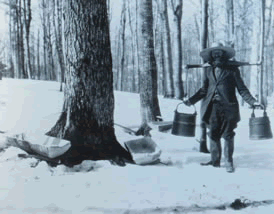 The warmth of first month of winter was beginning to make the sap tappers nervous. And there are plenty of maple harvesters around: little Connecticut ranks 10th in the United States in its maple syrup production – some 11,000 gallons annually.
The warmth of first month of winter was beginning to make the sap tappers nervous. And there are plenty of maple harvesters around: little Connecticut ranks 10th in the United States in its maple syrup production – some 11,000 gallons annually.
The American Indians were the first to recognize the treat offered by maple sap, boiled down to its syrupy or solid essences. But it is only recently that scientists have found that this sweetener is actually good for you. A single teaspoon contains nearly a quarter of your daily need of manganese and plus a good dose of zinc to boot. Both minerals are important ingredients in the body’s antioxidant defenses.
So our maples not only provide sweet treats, plus shade, oxygen, and terrific fall colors, they also contribute to our good health.





